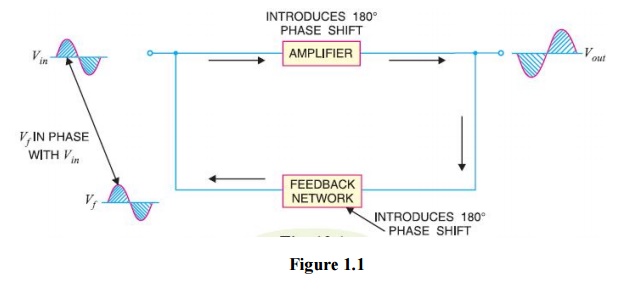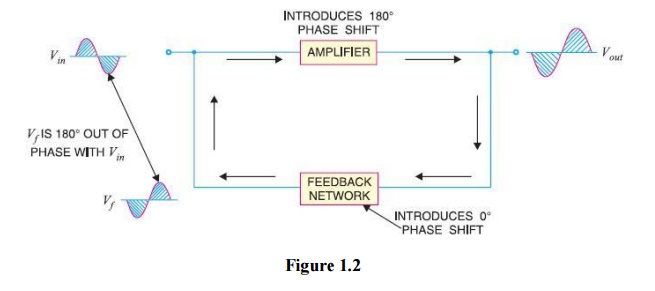Chapter: Electronic Devices and Circuits : Feed Back Amplifiers and Oscillators
Feedback: Positive and Negative feedback
Feedback
The process of injecting a fraction of output
energy of some device back to the input is known as feedback. The principle of feedback is probably as old as the
invention of first machine but it is only some 50 years ago that feedback has
come into use in connection with electronic circuits. It has been found very
useful in reducing noise in amplifiers and making amplifier operation stable.
Depending upon whether the feedback energy aids or opposes the input signal,
there are two basic types of feedback in amplifiers viz positive feedback and
negative feedback.
(i)
Positive feedback. When the
feedback energy (voltage or current) is in phase with the input signal and thus aids it, it is called positive feedback.
This is illustrated in Fig. 1.1. Both amplifier and feedback network introduce
a phase shift of 180°. The result is a 360° phase shift around the loop,
causing the feedback voltage Vf to be in phase with the input signal Vin.

The positive feedback increases the gain of the
amplifier. However, it has the disadvantages of increased distortion and
instability. Therefore, positive feedback is seldom employed in amplifiers. One
important use of positive feedback is in oscillators. As we shall see in the
next chapter, if positive feedback is sufficiently large, it leads to
oscillations. As a matter of fact, an oscillator is a device that converts d.c.
power into a.c. power of any desired frequency.
(ii)
Negative feedback. When the
feedback energy (voltage or current) is out of phase with the input signal and thus opposes it, it is called negative
feedback. This is illustrated in Fig. 1.2. As you can see, the amplifier
introduces a phase shift of 180° into the circuit while the feedback network is
so designed that it introduces no phase shift (i.e., 0° phase shift). The
result is that the feedback voltage Vf is 180° out of phase with the input
signal Vin.

Negative feedback reduces the gain of the
amplifier. However, the advantages of negative feedback are: reduction in
distortion, stability in gain, increased bandwidth and improved input and output
impedances. It is due to these advantages that negative feedback is frequently
employed in amplifiers.
Related Topics